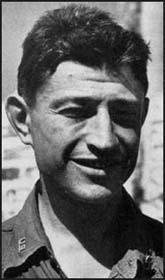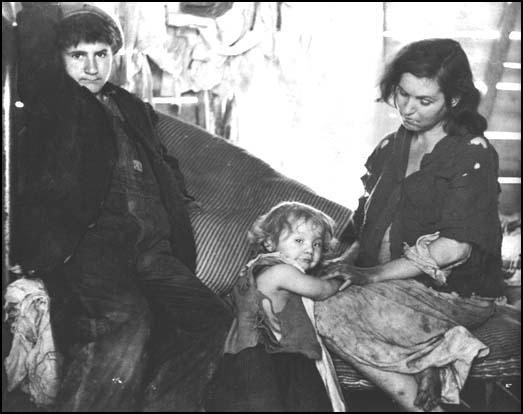Carl Mydans

Carl Mydans, son of a classical oboist, was born in Boston on 20th May, 1907. Mydans was invited by Roy Stryker in 1935 to join the the federally sponsored Farm Security Administration. This small group of photographers, including Esther Bubley, Marjory Collins, Mary Post Wolcott, Arthur Rothstein, Walker Evans, Russell Lee, Gordon Parks, Charlotte Brooks, John Vachon, Dorothea Lange and Ben Shahn, were employed to publicize the conditions of the rural poor in America.
In 1936 Mydans left the Farm Security Administration to join the recently established Life Magazine. In 1938 he married the journalist Shelley Mydans and the following year they were sent to Europe to cover the Second World War. At first they went to England before covering the war in Sweden, Finland, Portugal, Italy, China, and Hong Kong. During this period they travelled over 45,000 miles in pursuit of picture stories.
Mydans and his wife were in the Philippines when Japan bombed Pearl Harbor. Trapped in Manila they were captured by the Japanese Army and were interned with other Americans and remained in captivity until December 1943.
In 1944 Mydans accompanied Allied forces to Italy where he covered the campaign in Monte Cassino and the D-Day landings in France. The following year he took the famous photograph of General Douglas MacArthur as he returned to the Philippines. He also covered the finish of the Pacific War, including photographing Japan's signing the unconditional surrender to the the Allies on 2nd September, 1945.
After the war Mydans worked for Time Magazine in Japan and covered the 1948 earthquake in Fukui which resulted in 1,600 deaths. He later covered the Korean War before moving to England with his wife Shelley Mydans.
Mydans also covered the assassination of John F. Kennedy. One critic was later to say: "In 1963, he was the last to arrive at Life's New York office after President Kennedy's assassination, but his image of horrified American commuters reading the headlines on a train became famous." He also covered assignments for Life that took him to Greenland, Samoa, Yugoslavia and Vietnam.
Carl Mydans died on 16th August, 2004.

Primary Sources
(1) The Daily Telegraph (20th August, 2004)
By the mid-1930s, Mydans had taken to carrying a miniature camera on his assignments, and in 1935 he, Walker Evans, Ben Shahn and Dorothea Lange were hired by the Farm Security Administration to take pictures of impoverished farm workers in order to ignite public support for the New Deal. On the strength of these pictures he became the fifth photographer hired to work on Life, which had been set up in 1936.
His first assignment was a photographic essay on life in Freer, Texas, and his images of the gaunt and weather-beaten faces of farm workers became some of the best-known representations of the effects of the Great Depression on rural America.
In 1937, at a Christmas party for Life employees, Mydans met Shelley Smith, a journalist, whom he married the following year. When war broke out Mydans was sent to the Finnish-Russian front, and later, as the Germans advanced towards Paris, he covered the refugees fleeing from the city.
In 1941 Mydans and his wife were assigned (as a photographer-writer team) to cover the war in China. They were in Manila, capital of the Philippines, when the bombing of Pearl Harbor drew America into the war. On January 2 1942 they were captured and imprisoned.
After 22 months in prison, first in Manila and later in Shanghai, in 1943 Mydans and his wife were repatriated as part of a prisoner-of-war exchange. Carl Mydans immediately returned to the war, this time in Europe where he covered the Allied invasions of Italy and France. One of his most memorable photographs of this period was the disturbing image of townspeople in Marseilles about to shave the head of a Frenchwoman accused of collaborating with the Nazis.
At the end of the war he returned to China to photograph the liberation of Shanghai's notorious Lung Hwa prison. He also recorded the moment when General Douglas MacArthur waded ashore on his return to the Philippines in January 1945.
Mydans took particular pride in his pictures (captured from the top of a gun turret) of the Japanese surrender aboard the battleship USS Missouri in Tokyo Bay. He later recalled that he had felt some compassion for Shigemitsu Mamoru, the Japanese foreign minister, as he watched him "limp forward, his wooden leg tapping out his progress in the silence . . . He leaned on his cane, took off his top hat, and stripped off his gloves, and for an instant he seemed confused".
His simple image of commuters travelling home on November 22 1963, all reading newspapers with the headline "President Shot Dead", communicated the shock felt throughout America on the day after Kennedy's assassination.
(2) Christopher Reed, The Guardian (20th August, 2004)
One of the best known photographs from the second world war shows the supreme allied commander in the south-west Pacific, Douglas MacArthur, wading ashore in the Philippines in 1945 to fulfil his promise made three years earlier that "I will return." It was taken by cameraman Carl Mydans, who has died aged 97.
For the rest of his life, Mydans had to fight suspicions that the picture was staged. He would point out that MacArthur was usually unco-operative with photographers and insist that the general only did the walk once. But even if MacArthur did not pose, in one respect he performed with a canny knowledge of the pictorial potential.
United States forces returned to the islands in October 1944, having been driven out by the Japanese months after the Pearl Harbor attack in December 1941. But MacArthur did not land at the main island of Luzon until January 1945, and Mydans was the only photographer allowed to be present.
In preparation for the great man's arrival, army engineers had put out pontoons to the shore so he would not get his feet wet - and it was along those that Mydans ran to the beach in order to take his picture. But then he saw MacArthur's landing craft turn away parallel to the shore. Mydans ran along the sand until the craft headed inwards, and as he had expected: "I was standing in my dry shoes waiting." His photograph showed MacArthur sloshing towards the camera in his open-necked uniform and signature dark glasses, accompanied by staff officers and helmeted troops.
Mydans later photographed MacArthur at the Japanese surrender ceremony aboard the USS Missouri. "No one I have ever known in public life had a better understanding of the drama and power of a picture," Mydans later acknowledged.
He had plenty of comparisons to make. In his long career he took portraits of President Harry Truman, Winston Churchill, authors Gertrude Stein, William Faulkner and Thomas Mann, poet Ezra Pound, Soviet leader Nikita Khrushchev, Indian premier Indira Gandhi, and actor Clark Gable.
Mydans also covered the wars in Korea and Vietnam, the Soviet invasion of Finland in 1939, and the Japanese in China. He was often asked why he photographed war so much. "War is not my delight," he would reply. "War was the event of my years.
